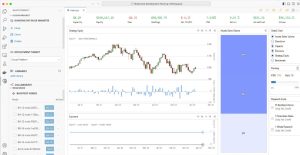The world of Forex trading has evolved with advancements in technology, and traders are increasingly relying on tools powered by artificial intelligence (AI) and big data. Open-source tools have become indispensable, offering flexibility, cost-effectiveness, and a robust community of developers. In this post, we explore five of the best open-source tools for Forex trading that leverage AI and big data.
1. QuantConnect

QuantConnect is a cloud-based algorithmic trading platform that supports multiple financial markets, including Forex. Built on an open-source infrastructure, it allows traders to backtest and deploy strategies written in Python, C#, or F#.
Key Features:
- Integrated with Forex brokers such as OANDA and FXCM.
- Historical Forex data for backtesting strategies.
- Machine learning integration using Python libraries.
Why Use It?
QuantConnect’s open-source Lean Engine enables traders to develop sophisticated trading algorithms using big data, test them extensively, and deploy them seamlessly.
Website: QuantConnect
2. TA-Lib (Technical Analysis Library)
TA-Lib is a powerful Python library for performing technical analysis. It provides over 150 functions for calculating indicators like Moving Averages, Bollinger Bands, RSI, MACD, and more.
Key Features:
- Supports advanced chart pattern recognition.
- Simple integration with Python data libraries like Pandas and NumPy.
- Lightweight and easy to implement in AI-based trading algorithms.
Why Use It?
If you’re building an AI model for Forex trading, TA-Lib is an essential tool for generating and analyzing technical indicators derived from big data.
Website: TA-Lib GitHub
3. TensorFlow
TensorFlow is an open-source AI framework widely used for deep learning and machine learning tasks. It’s ideal for creating predictive models to forecast currency pair movements.
Key Features:
- Neural network capabilities for complex modeling.
- Scalable for big data with distributed training.
- Supports integration with Python libraries for data preprocessing and visualization.
Why Use It?
TensorFlow can process large Forex datasets and build AI models that predict price movements based on historical patterns, market trends, and macroeconomic indicators.
Website: TensorFlow
5. ccxt (CryptoCurrency eXchange Trading Library)
While primarily focused on cryptocurrency trading, ccxt supports several Forex brokers, providing unified APIs for trading and data retrieval. It’s ideal for automating Forex trading strategies.
Key Features:
- Unified REST and WebSocket API for multiple brokers.
- Supports Python, JavaScript, and PHP.
- Ideal for algorithmic trading and data analysis.
Why Use It?
With its API-centric design, ccxt simplifies accessing Forex market data and executing trades programmatically.
Website: ccxt GitHub
How to Combine These Tools for Maximum Impact
Data Collection: Use ccxt to fetch real-time and historical Forex data.
Data Processing: Leverage Dask for handling large datasets efficiently.
Feature Engineering: Employ TA-Lib for calculating technical indicators.
Model Training: Build predictive models with TensorFlow.
Backtesting and Deployment: Test and deploy strategies using QuantConnect.
Open-source tools have revolutionized Forex trading by making AI and big data accessible to individual traders and small businesses. Whether you’re building predictive models, analyzing historical data, or deploying trading algorithms, these tools can help you gain a competitive edge.
Start exploring these open-source solutions today, and take your Forex trading strategies to the next level!
One Reply to “Top 5 Open-Source Tools for Forex Trading with AI and Big Data”
Comments are closed.